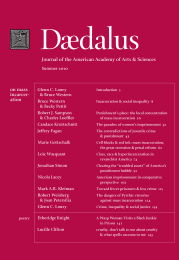Punishment’s place: the local concentration of mass incarceration
American crime policy took an unexpected turn in the latter part of the twenty-first century, entering a new penal regime. From the 1920s to the early 1970s, the incarceration rate in the United States averaged 110 inmates per 100,000 persons. This rate of incarceration varied so little in the United States and internationally that many scholars believed the nation and the world were experiencing a stable equilibrium of punishment.1 But beginning in the mid-1970s, the U.S. incarceration rate accelerated dramatically, reaching the unprecedented rate of 197 inmates per 100,000 persons in 1990 and the previously unimaginable rate of 504 inmates per 100,000 persons in 2008.2 Incarceration in the United States is now so prevalent that it has become a normal life event for many disadvantaged young men, with some segments of the population more likely to end up in prison than attend college.3 Scholars have broadly described this national phenomenon as mass incarceration.4
Often obscured by national trends are the profound variations in incarceration rates across states, cities, and especially local communities within cities. Like the geographically concentrated nature of criminal offending by individuals, a small number of communities bear the disproportionate brunt of U.S. crime policy’s experiment with mass incarceration.5 While the concept of “hot spots” for crime is widely acknowledged, the sources and consequences of incarceration’s “hot spots” are not understood as well. Although the inhabitants of such communities experience incarceration as a disturbingly common occurrence, for most other communities and most other Americans incarceration is quite rare. This spatial inequality in punishment helps explain the widespread invisibility of mass incarceration to the average American.
Motivated by this reality, our essay examines the spatial concentration of incarceration, focusing on its geographic manifestations in the quintessentially American city of Chicago. Assembling census data, crime rates, and court records into a common geographic referent, we explore rates of community-level incarceration from 1990 to 2006 to probe three general questions:
- How does incarceration impact neighborhoods differentially? What is the nature of spatial inequality in imprisonment rates across communities?
- What is the temporal trend? Have neighborhood patterns changed over time?
- What are the key correlates? For example, how do community-level features such as the crime rate and the concentration of poverty relate to the intensity of incarceration, across time and neighborhoods?
Overall, we demonstrate that mass incarceration is a phenomenon that is experienced locally and that follows a stable pattern over time. Hot spots for incarceration are hardly random; instead, they are systematically predicted by key social characteristics. In particular, the combination of poverty, unemployment, family disruption, and racial isolation is bound up with high levels of incarceration even when adjusting for the rate of crime that a community experiences. These factors suggest a self-reinforcing cycle that keeps some communities trapped in a negative feedback loop. The stability and place-based nature of incarceration have broad implications for how we think about policy responses.
. . .
Endnotes
- 1Alfred Blumstein and Jacqueline Cohen, “Theory of the Stability of Punishment,” Journal of Criminal Law and Criminology 64 (1973): 198–207.
- 2Bureau of Justice Statistics, “Prisoners in 2008,” (Washington, D.C.: U.S. Department of Justice, 2009), http://bjs.ojp.usdoj.gov/content/glance/incrt.cfm.
- 3Becky Pettit and Bruce Western, “Mass Imprisonment and the Life Course: Race and Class Inequality in U.S. Incarceration,” American Sociological Review 69 (2004): 151–169.
- 4Bruce Western, Punishment and Inequality in America (New York: Russell Sage Foundation, 2006).
- 5Todd R. Clear, Imprisoning Communities: How Mass Incarceration Makes Disadvantaged Neighborhoods Worse (New York: Oxford University Press, 2007).
